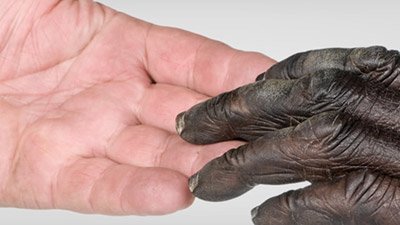The Differences Make the Difference
Differences in Gene Expression Distinguish Humans from Other Primates
While there is much similarity in DNA sequences and gene expression among them, there are also important differences. In the case examined, as in other cases, the differences make the difference.
Ever since the time of Darwin, evolutionary scientists have noted the anatomical similarities between humans and the great apes including chimpanzees, gorillas and orangutans. Over the last few decades, molecular biologists have joined the fray, pointing out the similarities in DNA sequences. Previous estimates of genetic similarity between humans and chimpanzees suggested they were 98.5–99% identical.1 However, after the sequencing of the chimpanzee genome last year, the DNA similarity was fixed at 96%.2 (See Chimp Genome Sequence Very Different from Man.) Now, a new study highlights important differences that go beyond the DNA sequence.
Yoay Gilad and colleagues published a paper in the prestigious science journal Nature in which they report an analysis of differences in gene expression among humans and other primates.3 Using a cDNA array (cDNA is complementary to mRNA and provides the exact code for proteins), they examined the expression of 907 genes in the liver from humans, chimpanzees, orangutans and rhesus macaques. They found a relatively large number of genes (110) that were expressed at different levels in humans and chimpanzees. In some cases, humans produce more of a particular gene product, and in other cases, less. This type of study of gene expression is quite different from those that investigate DNA sequences. Evolutionists themselves have suggested that gene regulation may be responsible for key differences between humans and chimpanzees.4
| Chimpanzee | Orangutan | Rhesus macaque | |
| Human | 110 | 128 | 176 |
| Chimpanzee | - | 150 | 141 |
| Orangutan | - | - | 129 |
Comparison of the number of differentially expressed genes in various primates. Adapted from Gilad, Y., Oshlack, A., Smyth, G.K., Speed, T.P., and White, K.P. Expression profiling in primates reveals a rapid evolution of human transcription factors, Nature 440:242–245, 2006.
While the DNA sequence of a gene specifies the amino acid sequence of the protein, the expression level is the amount of the protein that is made. In other words, the DNA sequence spells out the code for producing a specific protein whereas the expression level is the number of copies that will be produced. The amount of protein that is produced can make a profound difference, and in some cases a more important difference than a change in the DNA sequence.
For example, the amount of melanin (dark pigment in the skin) can be altered by the amount of UV light exposure (the reason people “tan” in the summer). The DNA sequence that determines the proteins involved in melanin production does not change, but the amount of those proteins does change. An increase in the amount of protein can lead to an increase in the amount of melanin.
Often, the amount of a protein that is produced is determined by the functional equivalent of “thermostats” called transcription factors. Transcription factors are proteins that bind to DNA just in front of the sequence that codes for a particular gene. The transcription factors serve as molecular switches to determine whether a gene is turned on or off, and how much of each to make. Clearly, the control of gene expression is very important.
Yoay and colleagues compared the level of expression for the 907 gene products across the various primates. They suggested that the number of differentially expressed genes followed an evolutionary progression. Humans and chimpanzees allegedly diverged from a common ancestor 5 million years ago, orangutans 13 million years ago and Rhesus 70 million years ago. Therefore, humans should have the fewest number of differentially expressed genes with chimpanzees, then orangutans, and the most with the rhesus macaque.
While that trend is apparent (Table 1), there is a discrepancy. Chimpanzees are supposed to be more recently related to orangutans than rhesus macaques. However, chimpanzees have slightly more differentially expressed genes compared to orangutans than compared to rhesus. In addition, the orangutan has essentially the same number of differentially expressed genes with humans as with the rhesus macaques.
Although 60% of the genes had similar expression profiles across the different species, this still leaves 40% that are altered in at least one species relative to the others. For example, the researchers found 19 genes that were expressed differently by humans, but the same in each of the other species. Each species has certain genes that are expressed at different levels than in the other species.
There may be even more significant differences in gene expression in humans and the various primates. This study only compared the gene expression in adult livers. Other organs, especially the brain, are likely to show even more differences in gene expression than the liver. It is also possible that there are many other differences in gene expression during development. For example, some genes may be expressed differently at various times as a baby grows in the womb.
As a creationist, I believe that God made humans, chimpanzees, orangutans and rhesus macaques separately (but on the sixth day of creation week). While there is much similarity in DNA sequences and gene expression among them, there are also important differences. In this, as in other cases, the differences make the difference.
Footnotes
- Wildman, D.E., Uddin, M., Liu, G., Grossman, L.I. and Goodman, M. 2003, Implications of natural selection in shaping 99.4% nonsynonymous DNA identity between humans and chimpanzees: Enlarging genus Homo, Proc. Natl. Acad. Sci. USA 100(12):7181–7188.
- The Chimpanzee Sequencing and Analysis Consortium 2005. “Initial sequence of the chimpanzee genome and comparison with the human genome.” Nature 437:69–87.
- Gilad, Y., Oshlack, A., Smyth, G.K., Speed, T.P., and White, K.P. Expression profiling in primates reveals a rapid evolution of human transcription factors. Nature 440:242–245, 2006.
- King, M.C. & Wilson, A.C. Evolution at two levels in humans and chimpanzees. Science 188:107–116, 1975.
Recommended Resources

Answers in Genesis is an apologetics ministry, dedicated to helping Christians defend their faith and proclaim the good news of Jesus Christ.
- Customer Service 800.778.3390
- © 2025 Answers in Genesis





